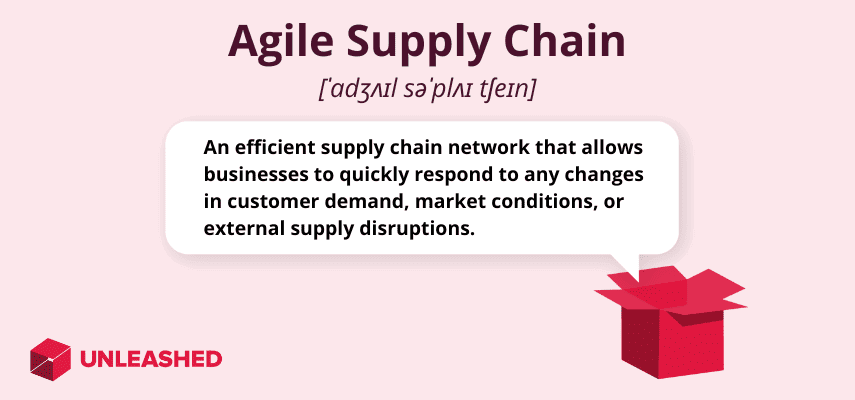
Supply chain agility is the ability of a supply chain to respond quickly and effectively to changes in customer demand and external pressures.
Agile supply chain management is especially important in today's dynamic business landscape, where customer expectations, technological advancements, and environmental uncertainties are constantly evolving and creating new challenges and opportunities for supply chain performance.
This guide breaks down supply chain agility – its benefits and the best-practice strategies for achieving it. Let’s dive in.
Agile supply chain meaning
An agile supply chain is a way of managing the production and distribution of goods and materials to quickly and efficiently respond to changes in customer demand, market conditions, or economic situations.
An agile supply chain has key characteristics – such as resiliency, flexibility, and visibility – which enable businesses to adapt to new trends and increase productivity.
Effective supply chain management helps you build an agile supply chain meaning you have greater flexibility to meet customer expectations, reduce operational costs, and gain a competitive edge in your industry.

Why is supply chain agility important?
Supply chain agility is important because it defines how quickly your business can adjust its operations and processes to meet changing customer demands, market conditions, and competitive pressures.
Three reasons why it’s important to improve supply chain agility:
- Remain adaptable to market changes: Responding quickly and effectively to changes in customer preferences, demand patterns, and product innovations helps you to capture new opportunities and gain a competitive edge.
- Enhanced responsiveness: The quicker your responses, the greater the speed and quality of your company's delivery, service, and support. This can reduce lead times, inventory costs, waste, and errors – and improve customer loyalty and retention.
- Risk mitigation and resilience: Supply chain agility helps you manage disruptions and risks that may affect your operations. An agile supply chain allows you to quickly identify, assess, and mitigate the impact of these events, and recover faster from any disruptions.
Supply chain agility and compliance
Supply chain agility is also important because it impacts the legal and regulatory environment that affects the supply chain operations.
Legal and regulatory considerations can include:
- Trade restrictions and protectionism policies
- Tariffs
- Sanctions
- Environmental regulations
- Labour laws
- Data privacy
- Intellectual property rights
These factors can have a significant impact on your supply chain performance, costs, risks, and opportunities. You should be aware of the legal and regulatory issues that affect your supply chain and take proactive measures to comply with them.
Some tips for using supply chain agility to manage compliance challenges:
- Conduct regular assessments of the legal and regulatory landscape in the markets where you operate or source from and identify potential changes or challenges that could affect your supply chain.
- Develop contingency plans for different legal and regulatory scenarios and situations, such as changes to trade agreements, tariffs, sanctions, or regulations.
- Establish collaborative relationships with suppliers, customers, logistics providers, and government agencies to facilitate information sharing, compliance, and problem-solving.
- Leverage technology and data to monitor and track the legal and regulatory compliance of their supply chain activities, such as customs clearance, product safety, quality standards, taxes, and duties.
Benefits of agile supply chain management
An agile supply chain is a key competitive advantage for any business that wants to thrive in the dynamic and uncertain market environment.
Six benefits of agile supply chain management:
- Improve efficiency, lower costs, and increase customer satisfaction
- Gain the ability to respond quickly and adapt to changing customer demands
- Seize new opportunities, innovate faster, and adapt to disruptions
- Attain the flexibility required to adjust to new trends, customise products, and prioritise resources
- Track the status of products, materials, and orders throughout the supply chain, enabling better decision-making and risk management
- Foster integrated and collaborative relationships with key supply chain partners, enhancing efficiency and innovation
An agile supply chain is a strategic asset that can drive business success. The benefits of an agile supply chain will lead to higher revenues, profits, and market share for your business.

Achieving agile supply chain: Strategies and best practices
To achieve agile supply chain management, businesses need to adopt the three key strategies of proactive planning, real-time data analytics, and collaboration. Each of these methods can be optimised with the right systems and technology.
1. Proactive planning
Proactive planning is about anticipating future demand and supply scenarios. It involves the preparation of contingency plans for different situations to help you reduce uncertainty and risk and optimise inventory levels and costs. Proactive planning requires constant monitoring and evaluation of your supply chain's performance and the external business environment.
2. Real-time analytics
Real-time data analytics uses AI, machine learning, and cloud computing technologies to collect, process, and analyse large volumes of data from various sources along your supply chain. This data and analytics provide insights into your customer behaviours, market demand patterns, supplier performance, and any potential disruptions.
3. Collaboration
Collaboration aids the coordination and integration of activities and processes across different supply chain partners. Supply chain collaboration helps to improve visibility, communication, and trust among stakeholders. It also helps to foster innovation and learning by sharing ideas and feedback.
4. Supply chain systems
Technology plays a crucial role in enabling agile supply chains because it supports the implementation of the three strategies above.
Supply chain management software can facilitate proactive planning through the provision of forecasting, simulation, optimisation, and scenario analysis tools. It also enhances real-time data analytics by providing platforms for data collection, storage, processing, visualisation, and distribution.
Agile supply chain examples
Circle One, a UK-based company that sells surfboards, wetsuits, and accessories is an example of an agile supply chain achieved with the help of inventory management software. Circle One implemented Unleashed to streamline its sales order and purchasing processes, reduce manual errors, and improve its inventory visibility and accuracy.
As a result, Circle One cut their sales order and purchasing admin time by 50%, increased their inventory turnover by 25%, and improved their customer satisfaction and loyalty.
John Deere is a global leader in manufacturing agricultural and construction equipment that uses two agile frameworks – Scrum and Scrum@Scale – to create supply chain solutions amid disruptions caused by the COVID-19 pandemic and successfully navigate the challenges of supply shortages and delays.
Results include a 79% improvement in cycle time, a 66% decrease in time to market, and a 20% reduction in overall costs.
What we can learn from these two examples is that agile supply chains allow organisations to respond quickly and effectively to changing customer demands and market conditions. An agile supply chain is flexible, adaptable, and resilient. This enables them to cope with uncertainty and volatility.
By leveraging digital technologies, data analytics, and collaboration you can optimise supply chain processes and performance.
Implementing an agile supply chain: Key considerations
Agile supply chain practices are essential for businesses that want to adapt to changing customer demands and market conditions. However, implementing them requires careful planning and execution, as well as overcoming some common challenges.
Some key factors to consider:
- Aligning your supply chain strategy with your business goals and customer needs
- Developing a culture of collaboration and communication across your supply chain partners
- Leveraging data and technology to enable supply chain visibility and decision-making
- Building flexibility and resilience into your supply chain processes and operations
- Continuously monitoring and improving your supply chain performance and customer satisfaction
By following these points, you can achieve a more agile and responsive supply chain that delivers value to your customers and your stakeholders.

Agile Supply Chain FAQs
What are the challenges of an agile supply chain?
Common challenges of an agile supply chain include higher complexity because of frequent changes in demand and supply and greater skill and capability requirements due to the need for cross-functional teams and continuous improvement.
How can I assess the agility of my current supply chain?
To assess the agility of your supply chain, evaluate the strengths and weaknesses of your supply chain processes, capabilities, and performance and benchmark them against best practices and industry standards.
How can I align my supply chain strategy with my business goals and customer needs?
To align supply chain strategy with business goals and consumer needs, first understand your customer segments, their expectations, preferences, and pain points, and then design your supply chain processes and capabilities accordingly.
How can I measure and improve the performance of my agile supply chain?
To measure agile supply chain performance, start tracking KPIs that reflect your agility goals.
These could include:
- Customer satisfaction
- Service level
- Order fulfilment rate
- On-time delivery rate
- Inventory turnover ratio
- Stock-out rate
- Supply chain cost
- Supply chain responsiveness
- Supply chain resilience
What are the challenges and risks of implementing an agile supply chain?
Key agile supply chain implementation challenges include the trade-offs between agility and efficiency, balancing the demand and supply variability, integrating different functions and partners across the supply chain, and aligning the incentives and culture among the supply chain stakeholders.
How can I overcome the barriers and resistance to change in my organisation?
To overcome change barriers in your business, follow a systematic change management process. It should involve communicating the vision and benefits of agility, engaging, and empowering the employees and managers, providing training and coaching, and creating a supportive and collaborative environment that recognises and rewards achievements and behaviours.

Navigating the future with supply chain agility
The world is changing rapidly and unpredictably, and businesses need to adapt to survive and thrive. A key factor that can help businesses navigate the future is supply chain agility.
Supply chain agility gives you the ability to respond quickly and effectively to changes in customer demand, market conditions, and external disruptions. It helps you to reduce costs, improve your customer satisfaction, and gain a competitive advantage.
To achieve supply chain agility, you need to adopt a holistic approach that involves people, processes, technology, and data. Foster a culture of collaboration, innovation, and learning across the supply chain. And leverage digital tools and platforms that enable real-time visibility, communication, and decision-making.
You should also rely on data and analytics to anticipate and mitigate risks, optimise performance, and identify opportunities.
